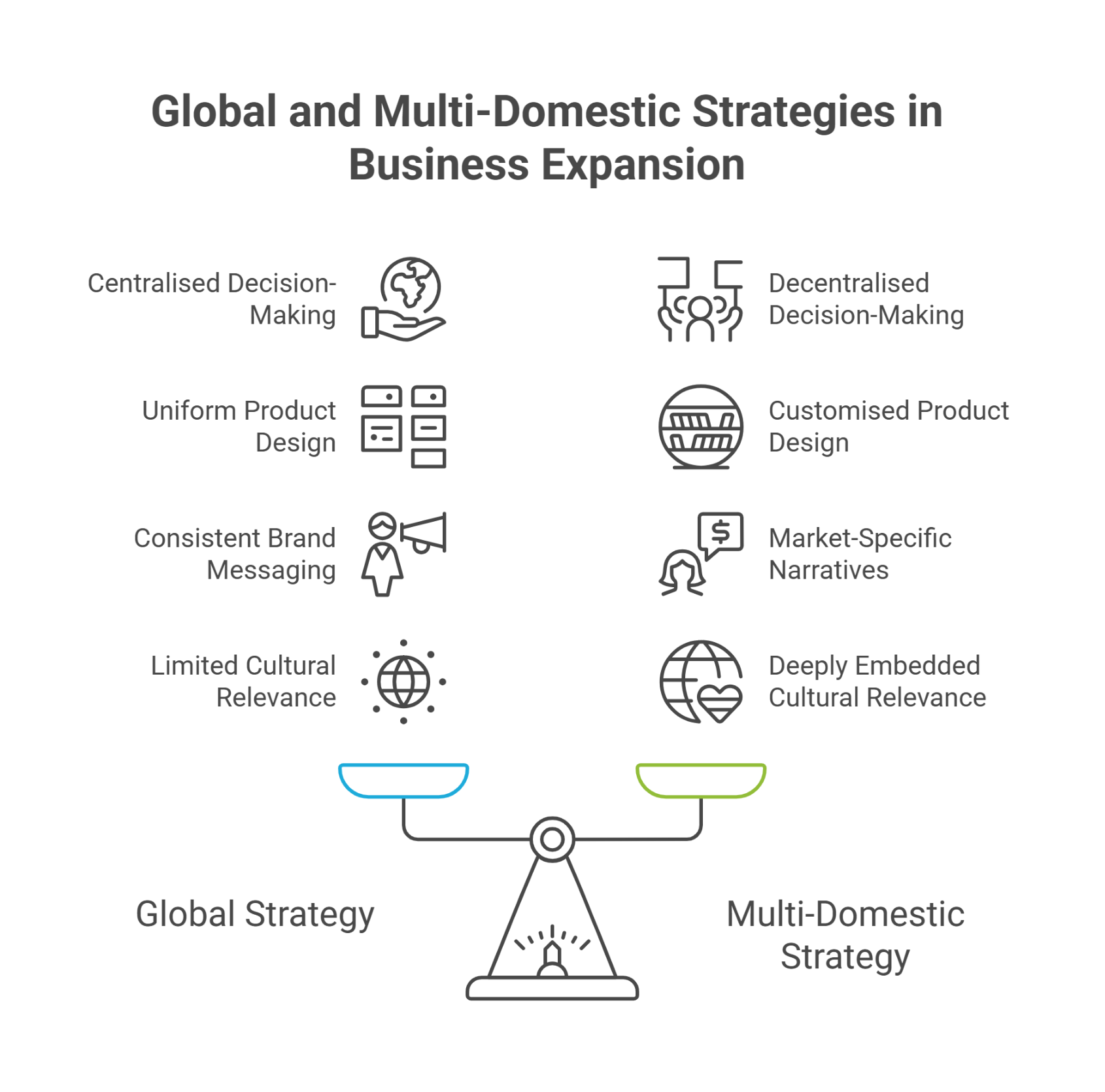When Netflix chose to invest heavily in Korean originals, or when Nestle developed four distinct MAGGI flavours inspired by India’s regional taste profiles like Amritsari Achari, Mumbaiya Chatak, Super Chennai, and Bengali Jhaal, it wasn’t simply about new content or packaging. It was a deliberate strategy. These companies weren’t following a uniform model, they were adopting a multi-domestic strategy, built around local responsiveness, cultural nuance, and contextual relevance.
Meanwhile, brands like Apple continue to grow through global strategies, driven by standardisation, scalability, and tightly unified brand ecosystems. But as markets become more linguistically diverse and digitally segmented, especially in geographies like India, the demand for culturally resonant, locally attuned experiences is redefining how global brands expand.
What is a Multi-Domestic Strategy?
A multi-domestic strategy is a decentralised approach to international expansion where each market operates with autonomy, tailoring offerings, messaging, and operations to its local culture, language, and behavioural norms. Rather than applying a uniform model across countries, businesses using this strategy adapt deeply to regional expectations, ensuring brand relevance within each unique context.
To better understand it, imagine a global retail brand expands into ten regions. Under a global strategy, those ten regions would receive the same product design, the same website, and the same marketing. With a multi-domestic strategy, however, each region could adapt the product based on local usage patterns. Brands can redesign their web UX for linguistic flow and build marketing narratives that actually speak to the people of that region.
Why Multi-Domestic Strategy Works in Diverse Markets
Markets shaped by linguistic complexity and cultural depth don’t respond to uniformity; they respond to familiarity. In environments where language, values, and daily behaviours shift drastically from one region to the next, a multi-domestic strategy enables businesses to operate with relevance, not assumption.
Across India, for example, consumer sentiment, purchase triggers, and brand perception differ sharply between states. This divergence is more than a challenge, it’s the foundation for competitive advantage when approached with localisation in mind. Businesses that recognise this aren’t only present across states, they adapt, speak, and behave like they belong there.
Recent data from HSBC reinforces this shift. 87% of Indian firms are prioritising the domestic market, aligning their strategies to focus inward with region-specific thinking. That pivot reflects the understanding that scale without cultural alignment risks eroding trust.
A compelling example of this strategic localisation is JioHotstar, the unified platform born from the merger of Disney+ Hotstar and JioCinema. Rather than serving a uniform content slate, JioHotstar curates deeply regional experiences, offering programming across multiple Indian languages
JioHotstar anchors its platform design in linguistic and cultural diversity, reflecting the essence of a multi-domestic strategy. Its content and user experience are shaped to align with the unique viewing patterns of each regional audience.
There are distinct strategic forces at play here:
- Consumer behaviour is fragmented: Brand decisions often depend on regional taste, tone, and shared narratives.
- Language drives engagement: Businesses that speak the way people think create stronger emotional access points.
- Regulatory environments vary: Tailoring operations to comply with regional norms creates smoother execution.
- Trust flows locally: Regional identity and relatability carry more weight than broad national appeal.
Comparing Global and Multi-Domestic Strategies in Business Expansion

Global and multi-domestic strategies often appear side by side in business playbooks, but their mechanics operate on completely different principles. Each serves a purpose, and each sets the foundation for very different kinds of growth. Where global strategy seeks unity across markets, multi-domestic marketing strategy builds specificity. One centralises efficiency, the other decentralises control.
The contrast becomes more meaningful when applied to real-world business expansion. For example:
- In consumer tech
- Apple delivers a uniform product localisation experience in every market, from design to UX to packaging. Its strategy is rooted in control, scale, and predictable brand perception. It doesn’t accommodate market-level customisation unless absolutely necessary.
- Compare that to how Spotify enters new regions. It curates playlists tied to local festivals, collaborates with regional artists, and even adapts its pricing structures to match local spending. The interface might feel familiar, but the experience is unmistakably contextual.
- In retail, the story continues
- Zara operates globally through a fast-fashion model that prioritises centralised design and rapid distribution. Its stores in India and Singapore look and feel the same.
- In contrast, Unilever and Nestle continuously adapt their offerings across geographies. They reformulate products to fit regional preferences, price points, or even ingredient regulations.
Here is a strategic comparison table of the pros and cons of multi-domestic strategy and global strategy:
Strategic Dimension | Global Strategy | Multi-Domestic Strategy |
Decision-Making | Centralised | Decentralised |
Product & Service Design | Uniform across markets | Customised per market |
Brand Messaging | Consistent tone and structure | Market-specific narratives |
Cultural Relevance | Limited | Deeply embedded |
Operational Trade-Offs Every Expansion Strategy Must Consider
No international expansion strategy comes without cost. The architecture that supports growth across borders has to balance responsiveness, control, cultural fluency, and operational efficiency, all at the same time. This is where many businesses underestimate the invisible work of expansion. Selecting between a global and a multi-domestic strategy depends on how well a business is operationally and structurally prepared to support it, not on what it prefers.
The following are the operational trade-offs leaders must anticipate when shaping their go-to-market model:
- Team Structure and Governance Models: Multi-domestic strategy requires functional autonomy at the regional level, including hiring local marketers, translators, compliance officers, and customer service professionals. Governance complexity increases as decision-making spreads across units.
- Cost of Coordination: Local websites, campaigns, SKUs, and processes must be managed independently. This introduces cost not just in execution, but in alignment, keeping multiple moving parts in sync without losing consistency.
- Technology Infrastructure Needs: Managing a decentralised strategy at scale demands systems that support modular design, flexible content management, and localised user interfaces.
- Speed vs Depth Trade-off: Global strategy enables rapid rollouts. Multi-domestic strategy takes more time, but lands with deeper relevance. Speed is sacrificed for impact, especially during market entry or campaign localisation.
- Brand Control vs Market Adaptation: The more local autonomy is granted, the harder it becomes to preserve brand integrity across markets. Without guardrails, variations may dilute brand equity. This demands strong global frameworks, even within flexible models.
Choosing the Right Strategy — Global Standardisation or Local Adaptation?
Expansion strategies don’t operate in isolation, they intersect with the markets they enter, the teams driving them, and the expectations of customers on the ground. What works for a SaaS product entering uniform Western economies may not hold when that same product touches down in linguistically fragmented or culturally layered regions. At that point, the decision between global consistency and local autonomy becomes a core strategic move with tangible operational consequences.
Here is how businesses can align strategy to market reality:
- Cultural Diversity of the Target Market: The more fragmented the audience, by language, customs, or content consumption, the more essential it becomes to localise every layer of the brand experience. Multi-domestic strategy works best where resonance matters more than reach.
- Regulatory and Legal Variation: When regulations vary not just between countries but within them, centralising compliance often slows execution. A localised model allows for agility, especially in high-complexity markets like India.
- Brand Positioning and Lifecycle Stage: Early-stage products looking to test-fit across regions may start globally for cost reasons. But mature products aiming to drive long-term retention will benefit more from a market-owned, culturally shaped approach.
- Operational Capacity for Localisation: Multi-domestic strategies demand infrastructure like translators, regional marketers, content governance systems, and agile deployment tools. If these aren’t in place, the strategy suffers.
- Strategic Objectives and Growth Horizon: If the goal is rapid presence, a global strategy delivers. If the goal is long-term loyalty, recurring value, and cultural connection, then a multi-domestic strategy becomes non-negotiable.
Enabling Scalable Localisation with Reverie’s Anuvadak
A multi-domestic marketing strategy delivers at scale only when localisation is embedded into core operations, not treated as an add-on. Many organisations recognise the need for cultural relevance but struggle with execution across content, updates, and governance.
Anuvadak, Reverie’s localisation platform, addresses this gap with a purpose-built solution for businesses managing multilingual content across regions. Below are the key capabilities that make Anuvadak a foundational enabler for seamless multi-regional growth:
- Faster Go-to-Market with Neural Translation
- Built on an Indian language-specific neural machine translation engine
- Automates large-scale content localisation while preserving cultural nuance
- Enables rapid rollout of localised web experiences across diverse markets
- Helps teams maintain messaging accuracy without delaying timelines
- CMS-Agnostic Integration
- Integrates smoothly with any CMS or website architecture
- Requires no structural changes or platform migration
- Easily fits into existing enterprise content workflows
- Minimises technical overhead and accelerates implementation
- Automated Sub-Domain Management
- Automatically generates and assigns multilingual sub-domains
- Streamlines deployment of regional language versions under dedicated URLs
- Enhances SEO performance through structured, language-specific domains
- Reduces engineering effort and simplifies web property management
- Centralised Oversight with Local Flexibility
- Offers a unified dashboard for managing localisation projects across markets
- Provides version control, translator collaboration, and real-time tracking
- Enables regional teams to adapt content without compromising governance
- Ensures localisation is structured, trackable, and aligned across markets
The Future Belongs to the Culturally Fluent Brand
Businesses aren’t only expanding into new markets, they are entering new cultural zones, language systems, and regional mindsets. As customer expectations continue to evolve, the brands that succeed will be those that sound, behave, and operate like locals, without losing their global structure.
The multi-domestic strategy empowers this kind of evolution. But strategy alone isn’t enough. Execution must be supported by intelligent localisation tools that don’t just translate, but transform experiences across markets.
Anuvadak brings this to the enterprise, enabling relevance at scale, speed without compromise, and cultural fluency through infrastructure. As regions like India become focal points for digital growth, building multilingual, user-centric experiences becomes a clear strategic advantage.
Book a free demo and explore how Anuvadak can power your localisation strategy.
Faqs
When should a business choose a multi-domestic strategy over a global strategy?
When entering culturally or linguistically diverse markets, a multi-domestic strategy enables deeper local relevance, regulatory alignment, and stronger consumer trust, especially in regions like India or Southeast Asia, where standardisation often limits market traction.
What industries benefit most from a multi-domestic strategy?
Industries with high cultural sensitivity, such as consumer goods, retail, media, healthcare, and education, gain the most. These sectors rely on local trust, preferences, and regulation alignment, which a multi-domestic approach effectively addresses.
How does a multi-domestic strategy impact operational complexity?
It increases complexity due to decentralised teams, diverse content, and local compliance. Platforms like Reverie’s Anuvadak help streamline execution by automating localisation while maintaining control, making complexity more manageable across multiple regions.
Can businesses blend global and multi-domestic strategies?
Yes, companies often centralise brand governance but localise execution. A hybrid model delivers consistency with cultural relevance. Anuvadak supports this by allowing flexible localisation under unified control, ensuring regional teams customise within brand-defined parameters.
What are the measurable benefits of a multi-domestic strategy?
Improved customer engagement, localised conversion, and long-term brand loyalty. Businesses often see higher interaction on regional platforms and more sustained growth when supported by structured localisation tools like Anuvadak.

